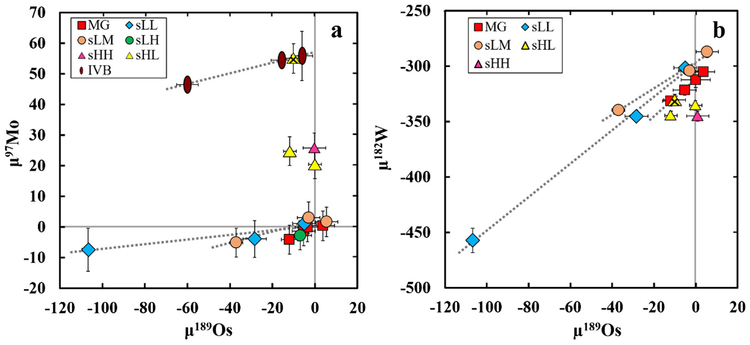The IAB iron meteorite complicated consists of a principal group (MG) and 5 chemical subgroups (sLL, sLM, sLH, sHL, and sHH). Here, mass-independent Mo and radiogenic 182W isotope compositions are reported for IAB complicated meteorites to consider the genetics and chronology, respectively, of the MG and subgroups.
Osmium isotopes are used to appropriate for cosmic ray publicity results on isotopes of Mo andW. The MG and three subgroups (i.e., sLL, sLM, and sLH), characterised by low Au abundances, have the identical Mo isotopic compositions within analytical uncertainty, constant with a standard genetic origin.
These meteorites, collectively with winonaites, are the solely cosmochemical materials but recognized with Mo isotopic compositions which can be an identical to Earth. The Mo isotopic compositions of two subgroups characterised by greater Au abundances (sHL and sHH) are an identical to each other within uncertainty, however differ from the low Au subgroups, indicating derivation from genetically distinct materials.
The MG has a 182W, publish calcium-aluminum inclusion (CAI) formation mannequin age of three.4 ±0.7Ma. One of the low Au subgroups (sLM) is ~1.7 Ma youthful, whereas the excessive Au subgroups are ~1.5-3 Ma older. The new Mo-W knowledge, coupled with chemical knowledge, point out that the MG and the low Au subgroups fashioned in numerous impact-generated melts, a few of which evidently fashioned on a chemically disparate, however genetically an identical mother or father physique.
The excessive Au subgroups probably fashioned through core-formation processes on separate, internally-heated mother or father our bodies from different IAB subgroups. The IAB complicated meteorites fall on a linear development outlined by 94Mo/96Mo vs. 95Mo/96Mo, alongside with most different iron meteorite teams. Variation alongside this line was attributable to mixing between not less than two nebular elements.
One part was probably a pure s-process enriched nucleosynthetic service, and the different a homogenized nebular part. Sombrerete, at present categorised as an sHL iron, has a Mo isotopic composition that’s distinct from all IAB complicated meteorites analyzed right here. Along with group IVB iron meteorites and some ungrouped iron meteorites, it falls on a separate line from different meteorites which can mirror addition of an r-process-enriched part, and it ought to not be categorised as a IAB iron.

Intact bioactivities and improved pharmacokinetic of the SL335-IFN-β-1a fusion protein that created by genetic fusion of SL335, a human anti-serum albumin fab, and human interferon-β.
Recombinant human interferon beta (rIFN-β) has lengthy been used as a first-line remedy for a number of sclerosis (MS), and any try to develop a long-acting rIFN-β is fascinating since just one pegylated model of long-acting rIFN-β-1a (Plegridy) is at present out there in clinics. Previously, we reported that SL335, a human Fab molecule particular to serum albumin, displays an prolonged serum half-life through using the FcRn recycling mechanism.
With the final objective of growing a long-acting rIFN-®, we generated a fusion assemble by linking human IFN-β cDNA to the C-terminus of the SL335 H chain at the DNA degree adopted by expression of the fusion protein, referred to as SL335-IFN-β-1a, in Chinese hamster ovary-S (CHO-S) cells. In its N-linked glycosylated type, the ensuing fusion protein was simply purified from the tradition supernatant through a three-step chromatography course of.
In vitro useful assays revealed that the fusion protein retained its intrinsic binding capabilities to human serum albumin (HSA) and interferon α/β receptor (IFNAR) that had been virtually an identical to these of parental SL335 and rIFN-β-1a (Rebif). In addition, the fusion protein possessed an antiviral efficiency and anti-proliferation exercise comparable to these of Rebif.
In pharmacokinetic (PK) analyses utilizing Lewis rats and cynomolgus monkeys, SL335-IFN-β-1a exhibited not less than a two-fold longer serum half-life and a considerably lowered renal clearance fee in contrast to these of Rebif. Finally, a four-week repeated dose toxicity research revealed no irregular toxicological indicators.
In conclusion, our outcomes clearly demonstrated that SL335-IFN-β-1a is worthy of additional improvement instead long-acting IFN-β therapeutic.
